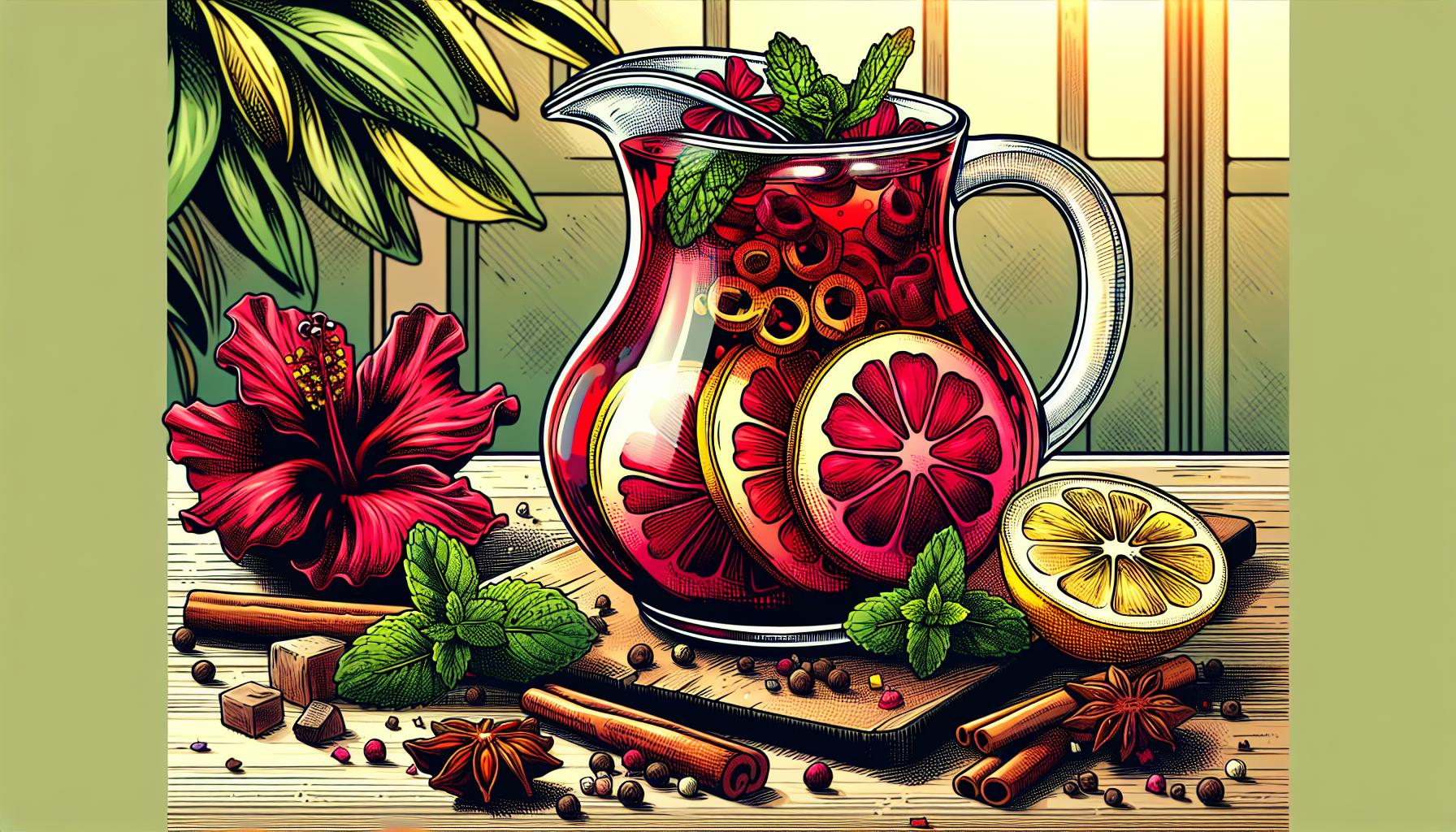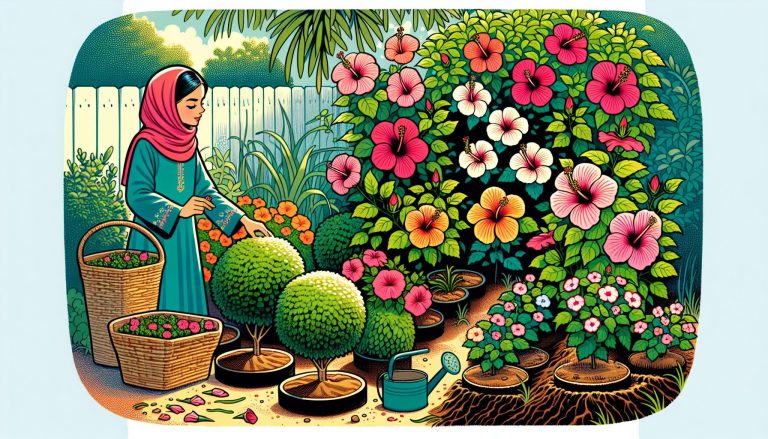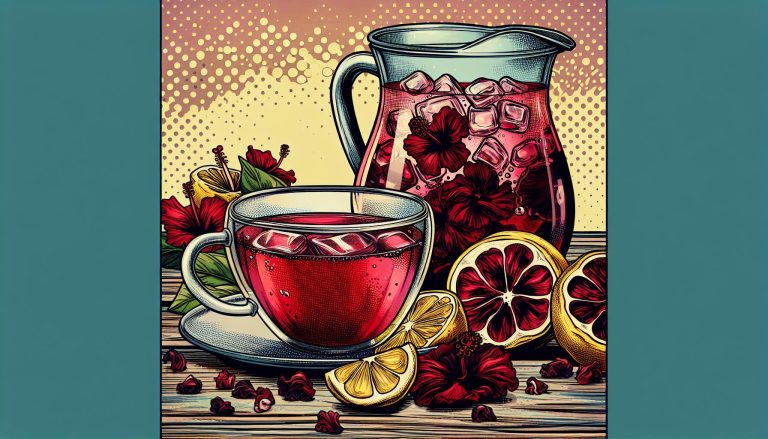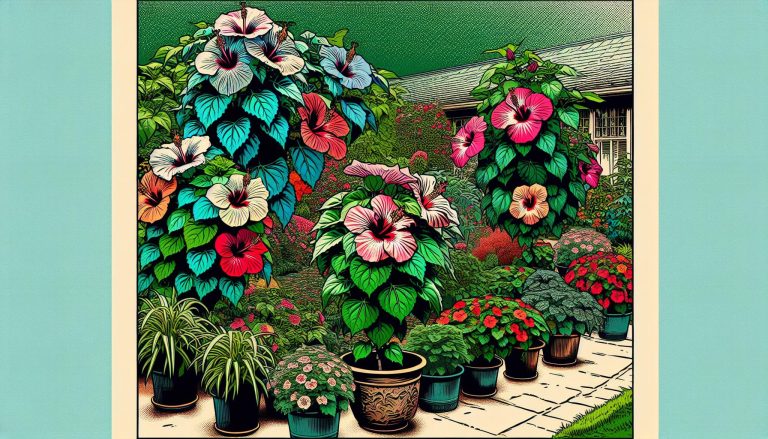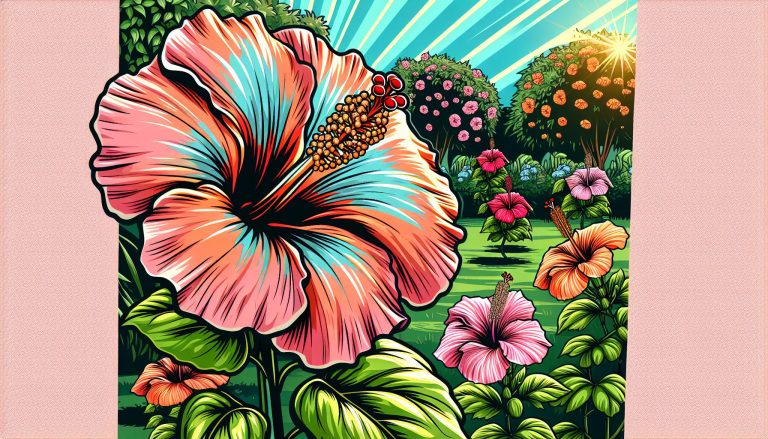How to Make Delicious Hibiscus Tea: Easy Guide for Hot and Iced Brews
I’ve always been drawn to the vibrant color and tangy flavor of hibiscus tea. This refreshing beverage, made from the calyces of the hibiscus flower, isn’t just delicious – it’s also packed with health benefits. From lowering blood pressure to boosting your immune system, hibiscus tea is a powerhouse of wellness.
In this article, I’ll guide you through the simple process of making your own hibiscus tea at home. Whether you prefer it hot or iced, sweetened or plain, you’ll soon be brewing this ruby-red delight like a pro. Get ready to explore the world of hibiscus tea and discover why it’s become a favorite among health-conscious tea lovers worldwide.
What Is Hibiscus Tea?
Hibiscus tea is a vibrant, ruby-red infusion made from the dried calyces of the Hibiscus sabdariffa flower. It’s a caffeine-free herbal tea known for its tart, cranberry-like flavor and refreshing qualities. This popular beverage is enjoyed both hot and cold in various cultures around the world, including Egypt, Mexico, and Sudan.
The main ingredients in hibiscus tea are:
- Dried hibiscus flowers
- Water
- Optional additions: sweeteners, spices, or fruit
Hibiscus tea’s unique taste profile comes from its high content of organic acids, including:
- Citric acid
- Malic acid
- Tartaric acid
These compounds contribute to the tea’s distinctive tangy flavor and potential health benefits. Hibiscus tea is rich in antioxidants, particularly anthocyanins and vitamin C, which may contribute to its various health-promoting properties.
Some common names for hibiscus tea include:
- Agua de Jamaica (Spanish)
- Roselle tea
- Sour tea
- Karkade (Arabic)
- Bissap (West Africa)
The versatility of hibiscus tea allows for numerous preparation methods and flavor combinations. It’s often enjoyed on its own or blended with other herbs and fruits to create unique taste experiences.
Health Benefits of Hibiscus Tea
Hibiscus tea offers numerous health benefits, making it a popular choice among health-conscious individuals. Here are some of the key advantages of incorporating this flavorful beverage into your diet:
- Blood Pressure Regulation
- Helps lower high blood pressure
- Contains anthocyanins and other antioxidants that support heart health
- May reduce the risk of hypertension-related complications
- Antioxidant Boost
- Rich in vitamin C, supporting immune function
- Contains polyphenols that combat oxidative stress
- May help protect cells from damage caused by free radicals
- Weight Management
- Low in calories, making it a great alternative to sugary drinks
- May help suppress appetite and reduce cravings
- Supports metabolism, potentially aiding in weight loss efforts
- Liver Health
- Exhibits hepatoprotective properties
- May help improve liver function and reduce the risk of fatty liver disease
- Supports the body’s natural detoxification processes
- Cholesterol Management
- May help lower LDL (bad) cholesterol levels
- Supports overall cardiovascular health
- Can be part of a heart-healthy diet
- Anti-Inflammatory Effects
- Contains compounds that may reduce inflammation in the body
- May help alleviate symptoms of inflammatory conditions
- Supports overall wellness and longevity
- Digestive Health
- Acts as a mild diuretic, supporting kidney function
- May help relieve bloating and constipation
- Supports a healthy gut microbiome
- Mood Enhancement
- Contains flavonoids that may have mood-boosting properties
- Can be a soothing and relaxing beverage
- May help reduce stress and anxiety when consumed regularly
By incorporating hibiscus tea into your daily routine, you can enjoy these potential health benefits while savoring its unique flavor profile. It’s important to note that while hibiscus tea offers many advantages, it’s best to consult with a healthcare professional before using it as a treatment for any specific health condition.
Ingredients Needed for Hibiscus Tea
To make delicious hibiscus tea, you’ll need a few key ingredients. Here’s what you’ll need to get started:
Fresh vs. Dried Hibiscus Flowers
Dried hibiscus flowers are the most common and convenient option for making hibiscus tea. They’re readily available in most grocery stores or online. Use 1-2 tablespoons of dried hibiscus flowers per cup of water for a strong brew. Fresh hibiscus flowers can be used if available, but they’re less common and may require more preparation. If using fresh flowers, use 3-4 calyces (the fleshy part surrounding the flower) per cup of water.
Additional Flavorings
Enhance your hibiscus tea with these optional flavorings:
- Sweeteners: Honey, sugar, or stevia to balance the tart flavor
- Citrus: Lemon or lime slices for added zest
- Spices: Cinnamon sticks, ginger slices, or whole cloves for warmth
- Herbs: Fresh mint leaves or lemongrass for a refreshing twist
- Fruit: Apple slices or berries for natural sweetness
These additions allow you to customize your hibiscus tea to suit your taste preferences. Experiment with different combinations to find your perfect blend.
Step-by-Step Guide to Making Hibiscus Tea
I’ll guide you through two simple methods for brewing delicious hibiscus tea: hot brewing and cold brewing. These techniques are easy to follow and produce excellent results.
Hot Brewing Method
- Boil water: Heat 4 cups of water in a kettle or pot until it reaches a rolling boil.
- Measure hibiscus: Add 1/4 cup of dried hibiscus flowers to a heat-safe pitcher or teapot.
- Pour water: Carefully pour the boiling water over the hibiscus flowers.
- Steep: Let the mixture steep for 5-10 minutes, depending on your desired strength.
- Strain: Use a fine-mesh strainer to remove the hibiscus flowers from the liquid.
- Sweeten (optional): Add your preferred sweetener to taste while the tea is still hot.
- Serve: Enjoy your hot hibiscus tea immediately or let it cool for iced tea.
- Combine ingredients: In a large pitcher, add 1/4 cup of dried hibiscus flowers to 4 cups of cold water.
- Refrigerate: Cover the pitcher and place it in the refrigerator for 8-12 hours or overnight.
- Strain: Remove the hibiscus flowers using a fine-mesh strainer.
- Sweeten (optional): Stir in your chosen sweetener until dissolved.
- Serve: Pour the cold brew hibiscus tea over ice and enjoy.
Tips for Perfect Hibiscus Tea
Use Quality Ingredients
I always start with high-quality dried hibiscus flowers for the best flavor. Organic varieties ensure no pesticides or additives interfere with the tea’s natural taste. Fresh, filtered water enhances the tea’s purity and allows the hibiscus flavors to shine through.
Control Steeping Time
Steeping time directly impacts the tea’s strength and flavor profile. For a balanced taste, I steep the flowers for 5-7 minutes. Longer steeping times (up to 10 minutes) produce a stronger, more tart flavor, while shorter times (3-5 minutes) result in a milder taste.
Experiment with Temperature
Water temperature affects the extraction of flavors and compounds from the hibiscus flowers. For hot brewing, I use water just off the boil (around 200°F or 93°C) to extract the full range of flavors without scorching the delicate petals.
Balance Sweetness
Hibiscus tea’s natural tartness can be balanced with sweeteners. I start with a small amount of honey, agave nectar, or stevia, then adjust to taste. This approach prevents overpowering the tea’s unique flavor profile while catering to individual sweetness preferences.
Enhance with Complementary Flavors
I often add complementary ingredients to create unique flavor combinations:
- Citrus: Lemon, lime, or orange slices
- Spices: Cinnamon sticks, ginger slices, or cardamom pods
- Herbs: Mint leaves or lemongrass
- Fruits: Apple slices or berries
These additions infuse the tea with extra depth and complexity.
Chill Properly
For iced hibiscus tea, I cool the brewed tea to room temperature before refrigerating. This prevents clouding and ensures a clear, vibrant appearance. I also make ice cubes from hibiscus tea to prevent dilution when serving over ice.
Store Correctly
To maintain freshness, I store brewed hibiscus tea in an airtight container in the refrigerator for up to 3-4 days. For longer storage, I freeze the tea in ice cube trays for future use in smoothies or as a refreshing addition to water.
Serving Suggestions
Hibiscus tea’s versatility shines through in its numerous serving options. I’ve compiled a list of creative ways to enjoy this vibrant beverage:
- Classic Hot Hibiscus Tea:
- Serve in a preheated mug
- Add a slice of lemon or orange for a citrusy twist
- Sweeten with honey or agave nectar to taste
- Refreshing Iced Hibiscus Tea:
- Pour over ice in a tall glass
- Garnish with fresh mint leaves and a lime wedge
- Add a splash of sparkling water for effervescence
- Hibiscus Lemonade:
- Mix equal parts hibiscus tea and fresh lemonade
- Serve over ice with a sprig of rosemary
- Garnish with a lemon wheel and fresh hibiscus flower
- Hibiscus Tea Cocktail:
- Combine chilled hibiscus tea with vodka or gin
- Add a splash of elderflower liqueur
- Garnish with a twist of grapefruit peel
- Hibiscus Tea Popsicles:
- Pour sweetened hibiscus tea into popsicle molds
- Add thin slices of fresh fruit like strawberries or kiwi
- Freeze overnight for a refreshing treat
- Hibiscus Tea Smoothie:
- Blend chilled hibiscus tea with frozen berries and banana
- Add a scoop of Greek yogurt for creaminess
- Sweeten with a drizzle of honey if desired
- Hibiscus Tea Spritzer:
- Mix hibiscus tea with club soda or tonic water
- Add a splash of cranberry juice for extra tartness
- Garnish with fresh berries and a sprig of thyme
- Hibiscus Iced Tea Latte:
- Combine chilled hibiscus tea with cold milk or plant-based alternative
- Sweeten with vanilla syrup or maple syrup
- Top with a sprinkle of cinnamon or dried hibiscus petals
These serving suggestions showcase hibiscus tea’s adaptability. Experiment with different combinations to find your favorite way to enjoy this flavorful and healthful beverage.
Storing Hibiscus Tea
Proper storage is crucial for maintaining the freshness and flavor of hibiscus tea. Here are some tips for storing both dried hibiscus flowers and brewed tea:
Storing Dried Hibiscus Flowers
- Keep in an airtight container: Store dried hibiscus flowers in a tightly sealed glass jar or airtight container to protect them from moisture and air exposure.
- Choose a cool, dark place: Place the container in a cool, dark area like a pantry or cupboard, away from direct sunlight and heat sources.
- Avoid humidity: Ensure the storage area is dry to prevent mold growth and flavor deterioration.
- Check for freshness: Properly stored dried hibiscus flowers typically last 1-2 years. Discard them if you notice any signs of mold or off-odors.
Storing Brewed Hibiscus Tea
- Refrigerate promptly: After brewing, allow the tea to cool to room temperature, then refrigerate it within 2 hours to prevent bacterial growth.
- Use airtight containers: Store brewed tea in clean, airtight glass containers or pitchers to maintain freshness and prevent absorption of other flavors.
- Consume within 3-5 days: For the best flavor and quality, drink refrigerated hibiscus tea within 3-5 days.
- Avoid adding sweeteners: If you plan to store brewed tea, leave it unsweetened. Add sweeteners just before serving to prevent fermentation and extend shelf life.
- Ice cube method: Pour cooled hibiscus tea into ice cube trays and freeze. Use these cubes to flavor and chill beverages without diluting them.
- Freezer-safe containers: For larger quantities, store hibiscus tea in freezer-safe containers, leaving some space for expansion.
- Thawing process: Thaw frozen tea in the refrigerator overnight or at room temperature for a few hours before consuming.
By following these storage guidelines, you’ll ensure your hibiscus tea remains fresh and flavorful, whether you’re storing dried flowers for future brewing or keeping brewed tea on hand for quick refreshment.
Conclusion
Making hibiscus tea at home is a simple and rewarding process. With its vibrant color tangy flavor and numerous health benefits it’s no wonder this caffeine-free beverage has gained popularity worldwide. Whether you prefer it hot or cold sweetened or plain there’s a hibiscus tea recipe to suit every taste.
I hope this guide has inspired you to explore the world of hibiscus tea. From its rich cultural history to its versatile serving options there’s so much to discover. So grab some dried hibiscus flowers and start brewing your own delicious and healthful concoction today. Your taste buds and your body will thank you!

